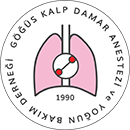

Trakeal Stenoz Cerrahisinde Nöromuskuler Blok Yönetimi; Retrospektif Değerlendirme
Sedat Saylan, Ali AkdoganKaradeniz Teknik Üniversitesi Tıp Fakültesi, Anesteziyoloji Ve Reanimasyon Ad. Trabzon, TürkiyeAmaç: Trakeal stenozun cerrahi tedavisinde ister trakeal rezeksiyon-anastomoz gibi uzun işlemler olsun, isterse rijid bronkoskopi ve dilatasyon gibi kısa cerrahi girişimler olsun, hasta konforunu sağlamak ve cerrahiyi kolaylaştırmak için derin nöromuskuler blok gerekebilir. Bu çalışmada trakeal stenozun cerrahi tedavisi sırasında sugammadeks kullanılarak yapılan nöromuskuler blok antagonizması incelenmiştir. Çalışmamızın amacı, postentübasyon trakeal stenoz ve posttrakeostomi trakeal stenoz olgularında uyguladığımız nöromuskuler blokajın sugammadeks ile antagonizmasını, postoperatif rezidual blok, komplikasyonlar ve postoperatif solunum paternine etkisi yönünden değerlendirmekti.
Yöntem: Kliniğimizde trakeal stenozun cerrahi tedavisi sırasında uyguladığımız anestezi yöntemleri ve nöromuskuler blok yönetimi prosedürlerinin etkinliğini değerlendirmek için hasta dosyaları, anestezi kayıt formları, erken postoperatif takip ve taburculuk süreci retrospektif olarak incelenmiştir. Trakeal stenoz tanısı alan 34 hastanın bir çoğuna farklı zamanlarda birden fazla cerrahi işlem uygulandığı için toplamda 140 girişimsel işlem ve anestezi uygulaması incelenmiştir. Trakeal stenoz cerrahisi geçiren ve nöromuskuler blok antagonizması için sugammadeks kullanılan hastalar çalışmaya dahil edilmiştir.
Bulgular: Hastalarımızın 34ü postentübasyon-posttrakeostomi trakeal stenoz olarak değerlendirildi. Hastalara kısa cerrahi işlem olarak rijid bronkoskopi (n=78), balon dilatasyon (n=35) ve stent (n=5) uygulanırken, 22 hastaya trakeal rezeksiyon-anastomoz cerrahisi uygulanmıştır. Kısa ve uzun cerrahi işlemlerde sugammadeks kullanımı sonrası, spontan solunuma başlama zamanının birbirine benzer olduğu görüldü. Sugammadekse bağlı herhangi bir komplikasyon tespit edilmedi.
Sonuç: Trakeal stenoz cerrahisinde anestezi derinliği ve kas gücünün monitörizasyonu altında sugammadeks kullanımının nöromuskuler blok antagonizmasında etkin ve güvenilir bir seçim olduğunu düşünmekteyiz.
Neuromuscular Block Management in Tracheal Stenosis Surgery; Retrospective Evaluation
Sedat Saylan, Ali AkdoganFaculty Of Medicine, Department Of Anesthesiology, Karadeniz Technical University, Trabzon, TurkeyObjective: In the surgical treatment of tracheal stenosis, whether in long procedures such as tracheal resection-anastomosis or in short procedures such as rigid bronchoscopy and dilatation, performing a deep neuromuscular block to provide patient comfort and facilitate the surgery. In this study, neuromuscular block antagonism using sugammadex during the surgical treatment of tracheal stenosis was investigated. The aim of our study was to evaluate the antagonism of the neuromuscular block with sugammadex in cases of postintubation tracheal stenosis and posttracheostomy tracheal stenosis in terms of postoperative residual block, complications and its effect on postoperative respiratory pattern.
Method: In order to evaluate the effectiveness of the anesthesia methods and neuromuscular block management procedures applied during the surgical treatment of tracheal stenosis, patient files, anesthesia record forms, early postoperative follow-up and discharge process were retrospectively reviewed. Since most of the 34 patients diagnosed with tracheal stenosis underwent more than one surgical procedure at different times, a total of 140 interventional procedures and anesthesia applications were examined. Patients who underwent tracheal stenosis surgery and used sugammadex for neuromuscular block antagonism were included in the study.
Results: 34 patients were evaluated as postintubation- posttracheostomy tracheal stenosis. While rigid bronchoscopy (n = 78), balloon dilatation (n = 35) and stent (n = 5) were applied to the patients as short surgical procedures, 22 patients underwent tracheal resection-anastomosis surgery. After the use of sugammadex in short and long surgical procedures, the time to start spontaneous breathing was found to be similar. No complications related to sugammadex were identified.
Conclusion: We argue that the use of sugammadex under the monitoring of anesthesia depth and muscle strength in tracheal stenosis surgery is an effective and reliable choice for neuromuscular block antagonism.
Makale Dili: Türkçe
(942 kere indirildi)

















